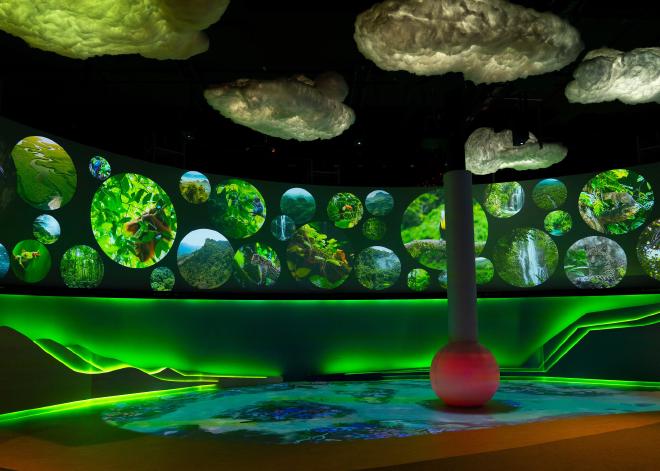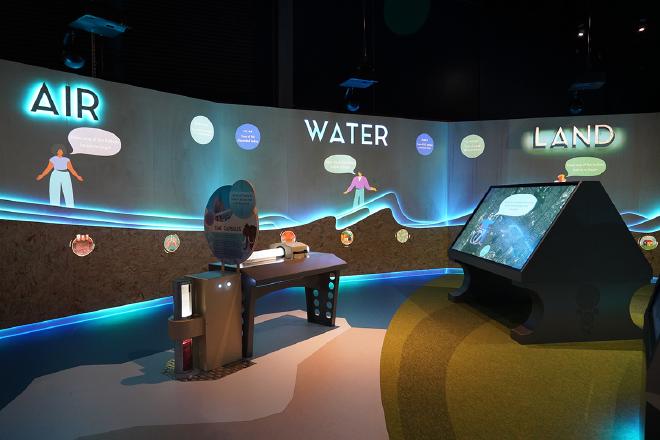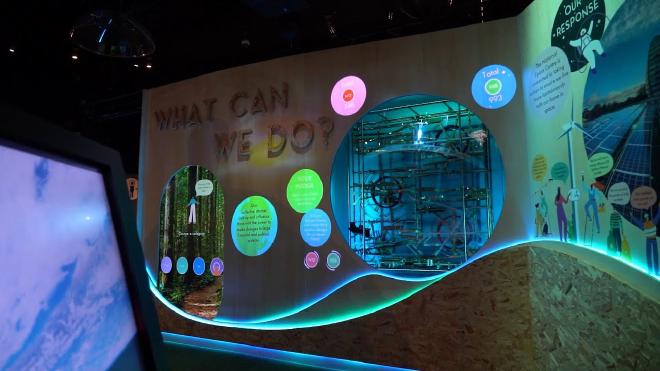Home Planet
Table of Contents
About #
The Home Planet Gallery at the National Space Centre, looks at the important roles that satellites have on Earth.
For all the following parts of the project, I was the sole developer and in charge of the technical approaches for the problems we had to solve with them.
Components #
Interactive Floor #

Description #
The interactive floor projection is an immersive experience that brings the beauty and wonder of the natural world to life. Developed using Unity for the logic and rendering, and OpenCV and Azure Kinects for depth detection, this immersive experience features four stunning biomes: a tundra with cracking ice, an ocean with sharks and whales, woodlands with stepping stones and a balancing log, and a coral reef with interactive fish.
Step onto the projection and watch as the floor comes alive beneath your feet, responding to your movements and allowing you to explore and interact with the different biomes. In the tundra, feel the chill as the ice cracks under your weight. In the ocean, walk alongside majestic whales and darting sharks, and marvel at the colorful coral and schools of fish in the reef.
Details #
- Made in Unity
- Azure Kinects for capturing depth data.
- Open CV for detecting where people are on the floor.
- Interactive Fish using boids and flocking to give a realistic experience.
- Integration with networked components including Madmapper and a custom networked video player for the panoramic display above the floor.
Gallery #
A small collection of images showing the different biomes for the interactive floor.
Satellite Orbit Viewer #
Description #
The satellite viewer uses live data from TLEs (Two-Line Element sets), to allow visitors to see the latest satellite positions and movements in real time around the planet. Each satellite is represented by a dot on the screen, with the option to filter to all satellites, or to specific subsets such as recent launches, Earth observations satellites, and even satellites that are on display around the National Space Centre.
Details #
- Made in Javascript with custom CSS and HTML elements
- Using Cesium.js and Satellite.js to handle the mathematics for calculating orbits
- Content management system to enable groups of satellites to be changed outside of the application
Satellite Image Viewer #
Description #
The satellite image viewer app is an engaging way for visitors to explore the world of satellite imagery. Using a large touch screen, visitors can browse a selection of real satellite images and learn more about what they show.
With a simple and intuitive interface that allows visitors to easily navigate through the images, each image is accompanied by a small description, providing context and information about what it shows. On some images, visitors can also use a before and after slider to see how events and changes in the environment can be observed by satellites.
Details #
- Made in Unity
- Custom content management system to allow images to be swapped out or reordered, or even add entirely new imagery to allow the exhibit to stay up-to-date and relevant.
Infographic Wall #

Description #
The infographic wall is an interactive and educational experience that showcases the incredible power of satellites to inform us about the land, the sea, and the air. Using capacitive touch sensors and real-time data, we have created a magical and accessible way for visitors to explore and learn about the health of our planet.
As visitors approach the wall, they will see a series of questions projected onto a wooden surface. By touching the wood, they can activate the sensors and the answer with vibrant and informative graphics, discovering how satellites are used to monitor important vitals about the Earth, as well as showing the impacts of climate change.
The wall also displays live counters for statistics such as CO2 concentration, global temperature, and the amount of rubbish dumped, highlighting the importance of protecting the planet.
Details #
- Made in Unity
- Capacitive touch sensors with Arduino
Choices Game #
Description #
Satellite Choices is an interactive 2D game that lets visitors explore the incredible power of satellites in their daily lives. As they play, they will embark on a journey through a typical day, choosing different options to affect how the story plays out. Along the way, they will learn how satellites are used in a variety of ways to make our lives easier, safer, and more connected. From tracking the weather to providing GPS navigation, satellites play a vital role in our daily lives, and the game is a fun and engaging way to learn more about this fascinating topic.
Marble Run #

Description #
As visitors approach the projection, they will be invited to make a pledge to use their money and vote in a way that supports the health of our planet. Once they have made their pledge, they can watch as their actions play out on the physical marble run, with a more exciting run happening if they choose to make the positive pledge.
Details #
- Made in Unity
- Using Brainboxes to control relays to power the motors on the Marble Run over the network.